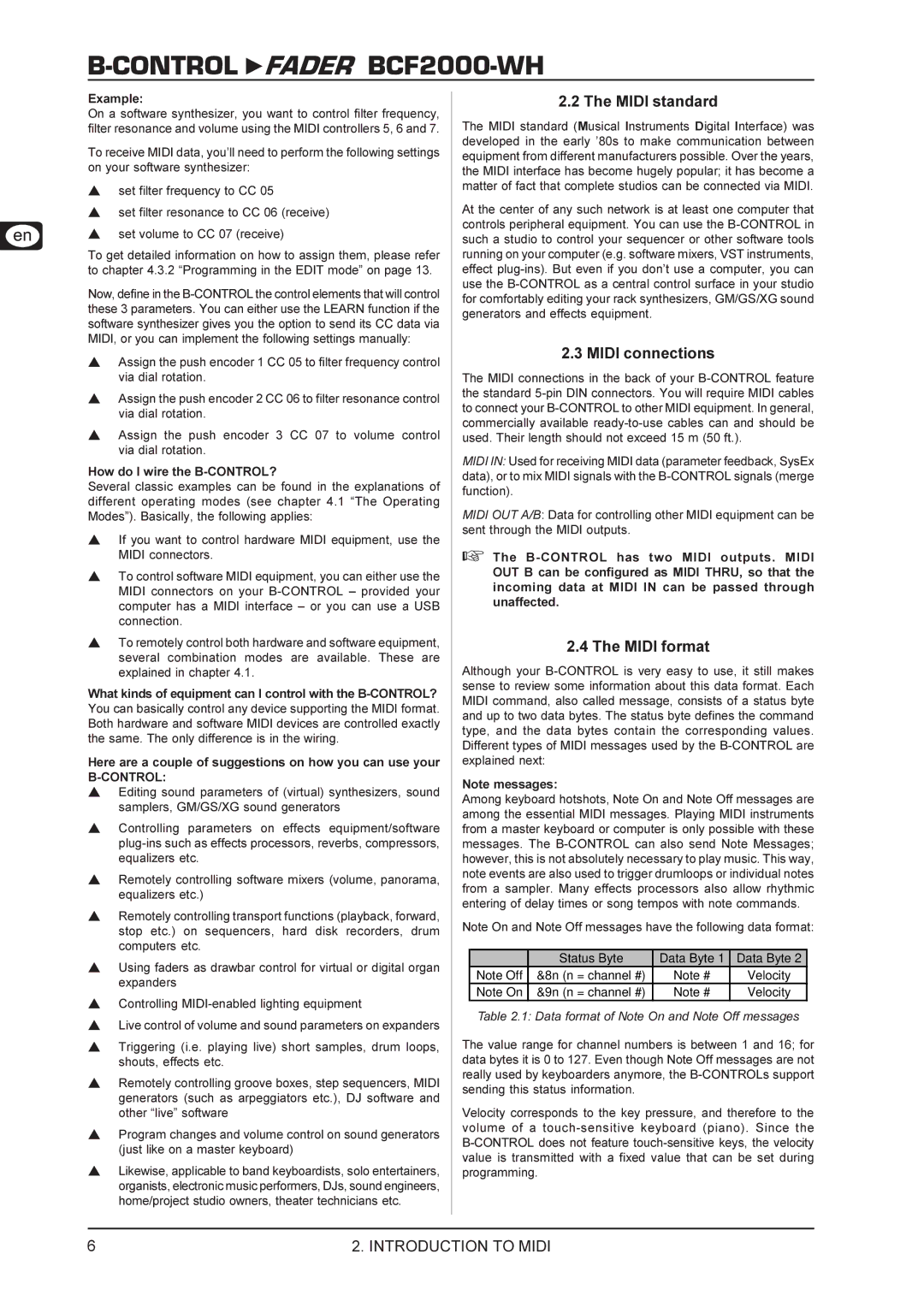
B-CONTROL  FADER
FADER BCF2000-WH
Example:
On a software synthesizer, you want to control filter frequency, filter resonance and volume using the MIDI controllers 5, 6 and 7.
To receive MIDI data, you’ll need to perform the following settings on your software synthesizer:
sset filter frequency to CC 05
sset filter resonance to CC 06 (receive)
sset volume to CC 07 (receive)
To get detailed information on how to assign them, please refer to chapter 4.3.2 “Programming in the EDIT mode” on page 13.
Now, define in the
sAssign the push encoder 1 CC 05 to filter frequency control via dial rotation.
sAssign the push encoder 2 CC 06 to filter resonance control via dial rotation.
sAssign the push encoder 3 CC 07 to volume control via dial rotation.
How do I wire the
Several classic examples can be found in the explanations of different operating modes (see chapter 4.1 “The Operating Modes”). Basically, the following applies:
sIf you want to control hardware MIDI equipment, use the MIDI connectors.
sTo control software MIDI equipment, you can either use the MIDI connectors on your
sTo remotely control both hardware and software equipment, several combination modes are available. These are explained in chapter 4.1.
What kinds of equipment can I control with the
Here are a couple of suggestions on how you can use your
sEditing sound parameters of (virtual) synthesizers, sound samplers, GM/GS/XG sound generators
sControlling parameters on effects equipment/software
sRemotely controlling software mixers (volume, panorama, equalizers etc.)
sRemotely controlling transport functions (playback, forward, stop etc.) on sequencers, hard disk recorders, drum computers etc.
sUsing faders as drawbar control for virtual or digital organ expanders
sControlling
sLive control of volume and sound parameters on expanders
sTriggering (i.e. playing live) short samples, drum loops, shouts, effects etc.
sRemotely controlling groove boxes, step sequencers, MIDI generators (such as arpeggiators etc.), DJ software and other “live” software
sProgram changes and volume control on sound generators (just like on a master keyboard)
sLikewise, applicable to band keyboardists, solo entertainers, organists, electronic music performers, DJs, sound engineers, home/project studio owners, theater technicians etc.
2.2 The MIDI standard
The MIDI standard (Musical Instruments Digital Interface) was developed in the early ’80s to make communication between equipment from different manufacturers possible. Over the years, the MIDI interface has become hugely popular; it has become a matter of fact that complete studios can be connected via MIDI.
At the center of any such network is at least one computer that controls peripheral equipment. You can use the
2.3 MIDI connections
The MIDI connections in the back of your
MIDI IN: Used for receiving MIDI data (parameter feedback, SysEx data), or to mix MIDI signals with the
MIDI OUT A/B: Data for controlling other MIDI equipment can be sent through the MIDI outputs.
+The
2.4 The MIDI format
Although your
Note messages:
Among keyboard hotshots, Note On and Note Off messages are among the essential MIDI messages. Playing MIDI instruments from a master keyboard or computer is only possible with these messages. The
Note On and Note Off messages have the following data format:
| Status Byte | Data Byte 1 | Data Byte 2 |
Note Off | &8n (n = channel #) | Note # | Velocity |
Note On | &9n (n = channel #) | Note # | Velocity |
Table 2.1: Data format of Note On and Note Off messages
The value range for channel numbers is between 1 and 16; for data bytes it is 0 to 127. Even though Note Off messages are not really used by keyboarders anymore, the
Velocity corresponds to the key pressure, and therefore to the volume of a
6 | 2. INTRODUCTION TO MIDI |
